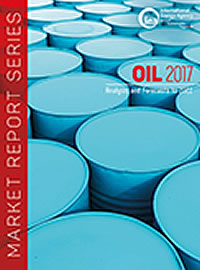
IEA: ‘Na 2020 dreigt tekort aan olie’
7 maart 2016 – Na 2020 zal er te weinig olie zijn om aan de mondiale vraag te kunnen voldoen, tenzij er nu snel meer geïnvesteerd wordt in het aanboren van nieuwe bronnen. Het Internationaal Energie Agentschap (IEA) waarschuwt voor forse prijsstijgingen.
Gisteren verscheen de editie 2017 van de jaarlijkse oliemarktanalyse van het IEA. Alsof er geen klimaatakkoord bestaat, is het rapport in feite één groot pleidooi voor nieuwe investeringen in de oliewinning.
 Uit het persbericht van het IEA
Uit het persbericht van het IEA
‘(…) Global oil supply could struggle to keep pace with demand after 2020, risking a sharp increase in prices, unless new projects are approved soon, according to the latest five-year oil market forecast from the International Energy Agency.
The global picture appears comfortable for the next three years but supply growth slows considerably after that, according to Oil 2017, the IEA’s market analysis and forecast report previously known as the Medium-Term Oil Market Report. The demand and supply trends point to a tight global oil market, with spare production capacity in 2022 falling to a 14-year low.
In the next few years, oil supply is growing in the United States, Canada, Brazil and elsewhere but this growth could stall by 2020 if the record two-year investment slump of 2015 and 2016 is not reversed. While investments in the US shale play are picking up strongly, early indications of global spending for 2017 are not encouraging.
Oil demand will rise in the next five years, passing the symbolic 100 mb/d threshold in 2019 and reaching about 104 mb/d by 2022. Developing countries account for all of the growth and Asia dominates, with about seven out of every 10 extra barrels consumed globally. India’s oil demand growth will outpace China by then. While electric vehicles are an important factor for oil demand, the IEA estimates they will displace only limited amounts of transportation fuel by 2022.

“We are witnessing the start of a second wave of US supply growth, and its size will depend on where prices go,” said Dr Fatih Birol, the IEA’s Executive Director. “But this is no time for complacency. We don’t see a peak in oil demand any time soon. And unless investments globally rebound sharply, a new period of price volatility looms on the horizon.”
The largest contribution to new supplies will come from the United States. The IEA expects US light tight oil (LTO) production to make a strong comeback and grow by 1.4 mb/d by 2022 if prices remain around USD 60/bbl. Expectations for US LTO are higher than last year’s forecast thanks to impressive productivity gains.
The United States responds more rapidly to price signals than other producers. If prices climb to USD 80/bbl, US LTO production could grow by 3 mb/d in five years. Alternatively, if prices are at USD 50/bbl, it could decline from the early 2020s.
Within OPEC, the bulk of new supplies will come from major low-cost Middle Eastern producers, namely Iraq, Iran, and the United Arab Emirates. Others like Nigeria, Algeria and Venezuela will decline. For its part, production from Russia is forecast to remain stable over the next five years.
The report also highlights changes in international oil-trade flows and investments in storage infrastructure. Asia will need to look beyond the Middle East to meet its growing import requirements. With OPEC countries focused on boosting domestic refining capacity to meet local demand and ramp-up exports of refined products, additional crude oil exports from Brazil and Canada will be higher than those from the Middle East. (…)’
The Wall Street Journal: ‘Change in tone’
Uit een bericht van de Wall Street Journal
‘(…) The forecast of the IEA—a Paris-based energy adviser to industrialized countries—marked a change in tone from its prediction three years ago that oil-demand growth may slow as soon as the end of this decade. The rise of renewable energy sources and cleaner fossil-fuels such as natural gas have led to similar predictions, including Royal Dutch Shell PLC’s forecast last year that rising oil demand could end within five to 15 years. (…)’
‘Tekenen herstel investeringen’
Uit een bericht van RTLZ
‘(…) Volgens het IEA zal de wereldwijde productie moeite krijgen om de vraag bij te houden. Dit komt mede doordat de investeringen in de oliemarkt vanwege de lage olieprijzen de afgelopen jaren sterk zijn teruggelopen. Eerder voorspelde het IEA dat ook dit jaar de investeringen verder zouden teruglopen. Het agentschap ziet nu evenwel tekenen van herstel. (…)’
Voor korte termijn zorgen over groeivertraging China
Tegelijk met het IEA-rapport werd bekend dat de oliehandel zich voor de korte termijn zorgen maakt over de vraag naar olie voor de korte termijn.
Uit een bericht van Finanzen
‘(…) Oliehandelaren maken zich zorgen om de groeivertraging in China, die de vraag naar olie kan aantasten. Volgens marktstrateeg Jeffrey Halley van broker Oanda zorgen lagere groeidoelstellingen in China en strengere regelgeving ervoor dat de vraag naar olie en grondstoffen in het algemeen is afgenomen. China mikt voor dit jaar op een economische groei van 6,5 procent, hetgeen minder is dan de groei van 6,7 procent die in het afgelopen jaar werd gerealiseerd. Het land is bovendien van plan om de staal- en kolenproductie dit jaar terug te dringen om vervuiling tegen te gaan, zo werd zondag bekend tijdens een jaarlijkse bijeenkomst van het Chinese parlement. (…)’
Bronnen
IEA, persbericht, 6 maart 2017: Global oil supply to lag demand after 2020 unless new investments are approved soon
IEA, rapport, 6 maart 2017: Market Report Series: Oil 2017 (pdf, 1 user, € 80; licence € 2.200)
The Wall Street Journal, 6 maart 2017: IEA Sees No Peak Oil Demand ‘Any Time Soon’ (via Blendle)
RTLZ, 6 maart 2017: ‘Wereldwijde vraag naar olie neemt komende jaren sterk toe’
Finanzen, 6 maart 2017: Oliemarkt maakt zich zorgen om groei China
Foto: BP



